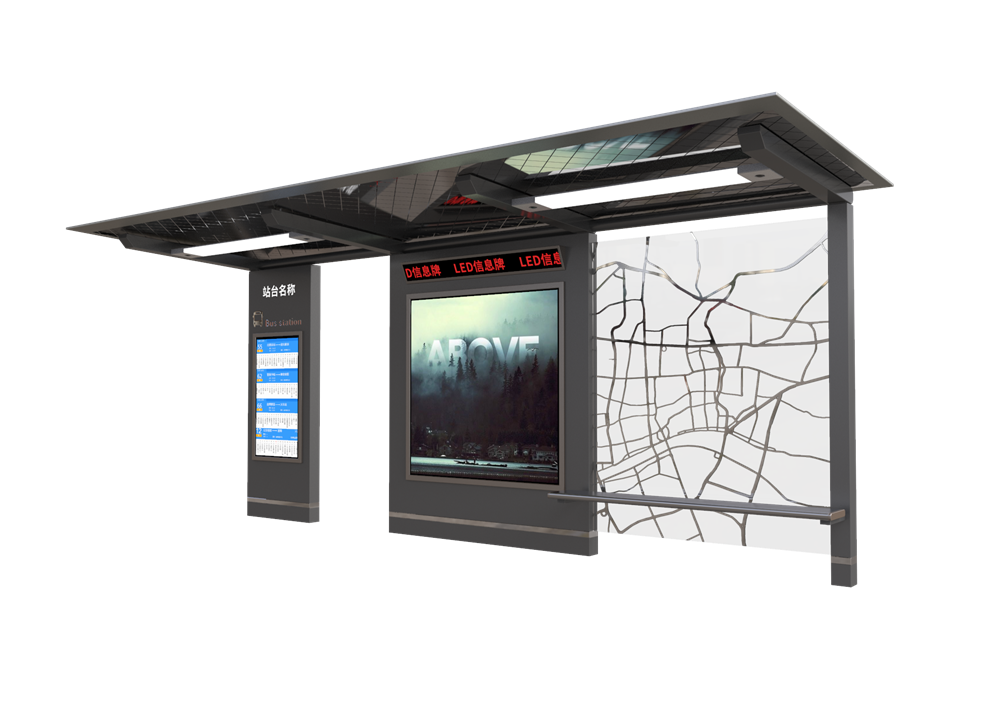The smart bus shelter is a cutting-edge public transportation facility that seeks to improve the overall user experience of the bus system. Through the use of advanced technology, the bus shelter provides passengers with real-time information on the arrival time of the next bus, as well as other relevant travel information. This enhances the convenience and efficiency of the public transportation system, resulting in a more sustainable and enjoyable mode of travel.
The smart bus shelter boasts the following features:
Real-time bus arrival information: Passengers can access bus arrival information through a digital display within the bus shelter, or through a mobile application. This feature greatly reduces waiting time and allows passengers to better plan their journey.
Predictive modeling: The intelligent bus shelter also integrates predictive modeling capabilities, which use historical data to estimate the time of the next bus arrival. This improves the accuracy of real-time information and reduces wait times even further.
Sensors and monitoring: The bus shelter is equipped with various sensors that monitor environmental conditions, such as temperature, humidity, and light level. This data can be used to provide passengers with accurate information on weather conditions or road conditions, enabling them to make more informed travel decisions.
Interactive mapping: The bus shelter also comes with an interactive map that shows passengers the best routes to take, transfers, and nearby facilities. This feature simplifies route planning and provides a more user-friendly experience.

The smart bus shelter offers the following benefits:
Improved user experience: The real-time information and predictive modeling features of the bus shelter provide passengers with a more convenient and enjoyable travel experience, leading to higher satisfaction levels.
Increased efficiency: The intelligent bus shelter reduces wait times and helps passengers better plan their journey, leading to a more efficient public transportation system.
Higher sustainability: The integrated mapping feature allows passengers to choose the most sustainable routes, leading to lower carbon emissions and a healthier environment.
Cost savings: The intelligent bus shelter reduces the need for bus drivers to manually provide bus arrival information, leading to cost savings for public transportation agencies.
The implementation of the intelligent bus shelter requires the following steps:
Collaboration with public transportation agencies: The implementation process should involve close collaboration between the manufacturer of the intelligent bus shelter and public transportation agencies to ensure that the product is tailored to their specific needs.
Installation of sensors and monitoring equipment: The bus shelter requires a network of sensors and monitoring equipment to collect and analyze data. These should be installed across the entire bus system to provide comprehensive real-time information to passengers.
Development of software and applications: The intelligent bus shelter requires custom software and applications to process and display data to passengers. These should be developed with user-friendliness in mind, ensuring that passengers can easily access bus arrival information without technical knowledge.
Promotion and education: Public transportation agencies should work with local authorities to promote the benefits of intelligent bus shelter to passengers. This can be achieved through social media campaigns, flyers, and targeted advertising.
In conclusion, the intelligent bus shelter is a game-changing innovation that transforms the public transportation experience for the better. It offers passengers real-time information, predictive modeling, interactive mapping, and other features that simplify journey planning and provide a more sustainable and enjoyable mode of travel.








 Share to:
Share to: